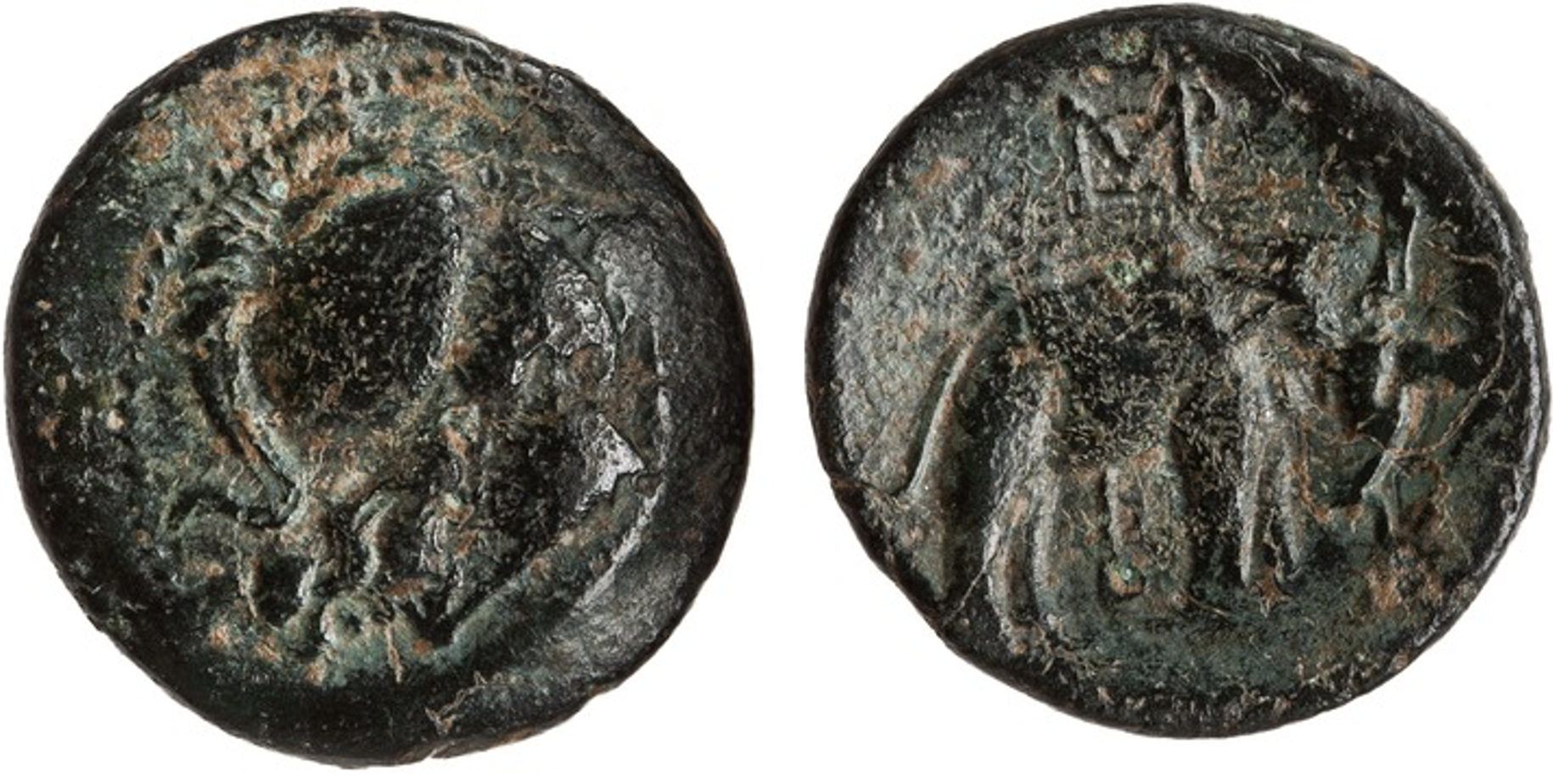2109 - Seleuceia ad Tigrim (Seleucus I) (AE Athena/elephant) over Seleuceia ad Tigrim (Seleucus I) (Athena/bull) (New York, ANS, 1944.100.44895 - Newell coll.): Difference between revisions
From SILVER
No edit summary |
No edit summary |
||
| Line 17: | Line 17: | ||
|Denomination=double unit | |Denomination=double unit | ||
|Coin series reference=SC I ; SC II, n° 128a. | |Coin series reference=SC I ; SC II, n° 128a. | ||
|Coin series reference overstruck=SC | |Coin series reference overstruck=SC, n° 125.1 | ||
}} | }} | ||
Revision as of 08:20, 30 May 2023
296 BCE - 295 BCE | ΒΑΣΙΛΕΩΣ ΣΕΛΕYΚΟΥ
Location/history
| Museum collectionMuseum collection: | New York, American Numismatic Society, 1944.100.44895 | |
| Private collection(s)Private collection(s) ᵖ: | E. T. Newell collection |
Overstriking coin
Description
| ObverseInscription or printing placed on the obverse.: | Head of Athena right, wearing crested helemet. | ReverseInscription or printing placed on the reverse.: | ΒΑΣΙΛΕΩΣ ΣΕΛΕYΚΟΥ (Greek) Elephant standing right. Above, monogram. |
Mint and issuing power
| MintIdentifies the place of manufacture or issue of a numismatic object.: | Seleuceia ad Tigrim | Ancient regionAncient region. | Mesopotamia | Modern countryModern country: Iraq | AuthorityIdentifies the issuing power. The authority can be "pretended" when the name or the portrait of X is on the coin but he/she was not the issuing power. It can also be "uncertain" when there is no mention of X on the coin but he/she was the issuing power according to the historical sources: | Seleucus I Nicator (satrap in 321-305 BC and Seleucid king in 305-281 BC) |
Chronology
| FromIdentifies the initial date in a range assigned in a numismatic context. 296 BCE toIdentifies the final date in a range assigned in a numismatic context.. 295 BCE | hellenistic periodTime period of the numismatic object. |
Physical description
| MetalThe physical material (usually metal) from which an object is made.: | WeightWeight of the numismatic object (in grams). in grams: 6.026.02 g <br />6,020 mg <br /> | DenominationTerm indicating the value of a numismatic object. Examples: tetradrachm, chalkous, denarius.: double unit | AxisDescribes the directional relationship between the obverse and reverse of a numismatic object.: 33 mm <br />0.3 cm <br /> |
References
| Coin referenceReference of the Coin: | Coin series referenceReference to coin series study: | SC I1SC I, SC II2SC II, n° 128a. |
Overstruck type
Description
| ObverseInscription or printing placed on the obverse.: | ReverseInscription or printing placed on the reverse.: |
Mint and issuing power
| MintIdentifies the place of manufacture or issue of a numismatic object. ᵖ: | Ancient regionAncient region. ᵖ | Modern countryModern country: | AuthorityIdentifies the authority in whose name (explicitly or implicitly) a numismatic object was issued. ᵖ: |
Chronology
| FromIdentifies the initial date in a range assigned in a numismatic context. toIdentifies the final date in a range assigned in a numismatic context.. | periodTime period of the numismatic object. |
Physical description
References
| Coin type referenceReference to coin series study ᵖ: | SC3SC, n° 125.1 |
Additional data
| Frequency of overstrikesFrequency of overstrikes: | Level of confidenceLevel of confidence of the identification: | ||
| RemarksRemarks: | |||
References
- ^ Houghton, Arthur - Lorber, Catharine (2002), Seleucid coins : a comprehensive catalogue. Part 1, Seleucus I through Antiochus III, New York - Lancaster - London, 2 v. (xxxviii, 488 p. + 300 p.), 101 pl.
- ^ Houghton, Arthur - Lorber, Catharine C. - Hoover, Oliver D. (2008), Seleucid coins : a comprehensive catalogue. Part 2, Seleucus IV through Antiochus XIII, 2 v., New York - Lancaster - London, (xxx), 120 p. of plates : ill., maps, tables
- ^ SC
